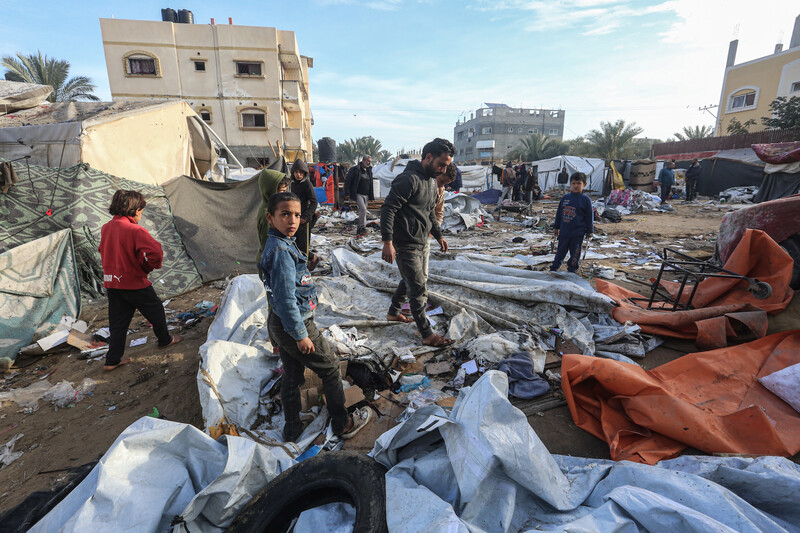Rights and Accountability 10 January 2025

Plastic and fabric scraps are what remain of displaced Palestinians’ tents following an Israeli attack in Deir al-Balah, central Gaza, 4 January.
APA imagesThe following is from the news roundup during the 9 January livestream. Watch the entire episode here.
Israel has continued its systematic campaign of destruction of Gaza, especially in the north, through the start of the new year.
The Palestinian health ministry in Gaza officially recorded the killing of 395 Palestinians and 936 injuries between 30 December and 8 January alone.The UN children’s fund UNICEF reported that during the first seven days of the new year, at least 74 children were killed in Israeli attacks.
UNICEF’s executive director Catherine Russell said, “For the children of Gaza, the new year has brought more death and suffering from attacks, deprivation and increasing exposure to the cold.”
The agency warned that the “continued lack of basic shelter – combined with winter temperatures – pose serious threats to children. With more than a million children living in makeshift tents, and with many families displaced over the past 15 months, children face extreme risks.”
Since 26 December, eight newborn babies have died from hypothermia.
In a feature we published on 4 January, our contributor Taghreed Ali writes, “Children, particularly infants, bear the brunt of the suffering in winter. They are ill-equipped for the cold and generate less body heat than older children or adults.”
Ali profiled grieving parents and Dr. Ahmed al-Farra, the head of pediatrics at Nasser Medical Complex.
Al-Farra told The Electronic Intifada that his department has been receiving more than five cases per day of children suffering from hypothermia.
On our last livestream, we reported on Israel’s abduction and subsequent disappearing of Dr. Hussam Abu Safiya, the director of the Kamal Adwan hospital in Beit Lahiya, in the north of Gaza.
The hospital was surrounded and destroyed by Israeli forces on 27 December, after more than 80 days of relentless attacks because doctors refused to abandon their patients and staff.
Abu Safiya has still not been heard from, although the Geneva-based Euro-Med Human Rights Monitor said it had received information that “his health has deteriorated due to the torture he endured during his detention, particularly while being held at the Sde Teiman military base in southern Israel. Euro-Med Monitor warns of the grave risk to his life, following patterns of deliberate killings and deaths under torture previously suffered by other doctors and medical staff arrested from Gaza since October 2023.”
The Israelis “subsequently transferred Dr. Abu Safiya to a field interrogation site in the al-Fakhura area of Jabaliya refugee camp. There, he was forced to strip off his clothes and was subjected to severe beatings, including being whipped with a thick wire commonly used for street electrical wiring. Soldiers deliberately humiliated him in front of other detainees, including fellow medical staff. He was later taken to an undisclosed location before being transferred to the Sde Teiman military camp under Israeli army control.”
On 2 January, Physicians for Human Rights-Israel had submitted a request on behalf of Abu Safiya’s family to obtain information about his condition and facilitate a lawyer’s visit. But the Israelis claimed to have no record of his detention.Euro-Med Monitor warned that Abu Safiya could face a similar fate as Dr. Adnan al-Bursh, head of the orthopedics department at al-Shifa hospital in Gaza City. Al-Bursh was killed by torture at Israel’s Ofer prison last April.
Another doctor, Abu Safiya’s colleague Dr. Iyad al-Rantisi, who was the head of the obstetrics department at Kamal Adwan hospital, was also killed by torture at a facility run by the Shin Bet, the Israeli intelligence agency, one week after he was detained in November 2023. Euro-Med added that Israel concealed his death for more than seven months.
Earlier this week, Hussam Abu Safiya’s mother died of a heart attack.
As we reported, her grandson, Hussam Abu Safiya’s son, Ibrahim, was killed by an Israeli drone strike in October.Hussam Abu Safiya led the funeral prayers for Ibrahim before burying him in the hospital’s courtyard. At the time, he accused the Israeli army of killing his son as a punishment for refusing to abandon the hospital and his staff and patients.
With the total decimation of Kamal Adwan hospital as well as the Indonesian hospital, and the prevention by the Israelis of any medical workers to enter the north of Gaza, there is only one hospital left barely operating.
The aid group Relief International reports that Al-Awda hospital in Jabaliya is the last medical facility in the north, and it is hanging on by a thread.
On 3 January, Al-Awda received orders to forcibly remove all hospital staff and patients “or else the facility would be bombed, including all of those inside,” Relief International stated.
The group added that the hospital has been targeted, “destroying the fuel tank and last running generator, as shelling in the surrounding area continues.”
Sixty three staff and 34 patients remain inside, Relief International said. “The facility has no electricity but continues to receive patients, providing the best possible treatment with no fuel, and a severe shortage of medication and medical supplies.”
Zero fuel reserves
The United Nations warned on Wednesday that “zero fuel reserves to operate electricity generators at hospitals across Gaza are placing the lives of patients [including] newborns at grave risk.”
On Wednesday, the Nasser Medical Complex in Khan Younis announced that all the generators at the facility have stopped, and only a small generator is currently operating with an amount sufficient for three hours.
In a press conference also on Wednesday, the ministry of health in Gaza stated that there is no fuel stock in hospitals due to the restrictions imposed on fuel entry and looting.
The ministry warned that if no additional fuel is received, this shortage will cause a catastrophe affecting the functioning of oxygen generators, medicine refrigerators and incubators.
The health ministry added that a patient died on Wednesday due to the lack of fuel needed to operate kidney dialysis machines. Hours later, the ministry reported that a small amount of fuel to operate hospital generators was received, which would allow for only 24 hours of continuation of services.
Our contributor Abubaker Abed reported on the kidney disease crisis across Gaza.In a feature we published on 8 January, Abed profiled several patients as well as Abdel-Naser Abu Aisha, the head nurse of the dialysis department at Al-Aqsa hospital in Deir al-Balah.
Israel kills aid workers, empowers gangs
Israel is continuing not just to prevent humanitarian aid, fuel, medicines and food as the ethnic slaughter entrenches in north Gaza, but it is also continuing to destroy the aid and kill those delivering it.
Israeli forces are also bolstering and supporting the actions of armed gangs in looting and undermining social order.According to the aid group Oxfam this week, of only 34 trucks of food and water “given permission to enter the north Gaza governorate over the last 2.5 months, deliberate delays and systematic obstructions by the Israeli military meant that just 12 [trucks] managed to distribute aid to starving Palestinian civilians.”
For three of the 12 aid trucks able to enter, Oxfam said, “once the food and water had been delivered to the school where people were sheltering, [the school] was then cleared and shelled within hours.”
Sally Abi Khalil, Oxfam’s Middle East and North Africa director stated, “The situation in Gaza is apocalyptic and people are trapped, unable to find any kind of safety. The absolute desperation of having no food or shelter for your family in the biting cold of winter. It is abhorrent that despite international law being so publicly violated by Israel and starvation being used relentlessly as a weapon of war, world leaders continue to do nothing.”
The United Nations’ Under Secretary-General for Humanitarian Affairs and Emergency Relief Coordinator Tom Fletcher stated on 6 January that the UN’s efforts to save lives are at a “breaking point.”
Fletcher said, “An Israeli strike seriously injured three people at a known food distribution point where a partner of the World Food Programme was operating. Israeli soldiers fired over 16 bullets at a clearly-marked UN convoy at the checkpoint from the south to the north.”
Armed Palestinian gangs, he added, “hijacked six fuel tankers entering from the Kerem Shalom crossing, leaving us hardly any fuel for aid operations. These incidents are part of a dangerous pattern of sabotage and deliberate disruption.”
Fletcher added that on 3 January, “Israeli forces increased attacks during the movement of a 74-truck aid convoy. A drone strike hit a vehicle from the local community which was protecting part of the convoy. And just a few days ago, a UN mission out of Jabaliya ran into hostile Israeli soldiers who threatened critical patients and arrested four of them.”
“There is no meaningful civil order,” Fletcher stated. “Israeli forces are unable or unwilling to ensure the safety of our convoys. Statements by Israeli authorities vilify our aid workers even as the military attacks them. Community volunteers who accompany our convoys are being targeted. There is now a perception that it is dangerous to protect aid convoys but safe to loot them.”
Euro-Med Human Rights Monitor reported this week that Israel’s support of organized gangs in Gaza in order to steal humanitarian aid is a calculated attempt to “spread chaos and insecurity as part of its genocidal war and create disastrous conditions that will result in the destruction of Palestinians in the Strip as a whole.”
The Gaza government media office stated on 2 January that the Israeli army assassinated Mahmoud Salah, the director general of the Palestinian police in the Gaza Strip, and his assistant Hussam Shahwan.
The killings were “a cowardly assassination operation that targeted them while they were performing their national and humanitarian duty in the al-Mawasi area in Khan Younis governorate in southern Gaza, which the occupation claims is a ‘safe humanitarian’ area, resulting in more martyrs and wounded,” the media office stated.
“This escalation comes within a clear plan by which the Israeli occupation aims to create an administrative and governmental vacuum, and spread chaos and security chaos in the Gaza Strip, in an attempt to undermine the steadfastness of our people and destabilize them,” the media office warned.
“The horrific rise in the number of martyrs of aid workers to 736 shows the extent of the crimes committed by the occupation, which target everyone who tries to provide aid and relief to our afflicted Palestinian people.”
Journalists killed
Israel has killed two journalists in Gaza since the start of the new year.
On 2 January, Israel killed Hassan al-Qishaoui in a drone strike.
On 3 January, Omar Salah al-Diraoui, who was a photojournalist and worked with a number of news agencies, was killed in an Israeli bombing of his house in the al-Zuwaida area in the central Gaza Strip, according to the Gaza government media office.The media office says that their deaths bring the number of journalists and media workers killed by Israel since October 2023 to 202.
Our contributor Abubaker Abed spoke at a press conference on the relentless attacks against journalists and the continuing silence by western media.
Highlighting resilience
Finally, as we always do, we wanted to share images of people expressing defiance and resilience in the face of Israel’s campaign of destruction.
Twitter/X user @NourGaza posted these photos of birds on top of her tent, after a rainstorm:
She says, “I didn’t want to let all the rainwater fall off the top of the tent, so the birds could drink from it.”Ali Jumaa of north Gaza posted this video of himself, his friend, and children playing during a hailstorm:
And journalist Anas al-Sharif, who is one of the remaining journalists in north Gaza and has been separated from his family because of his work, was reunited with his baby son Salah this week.





Add new comment